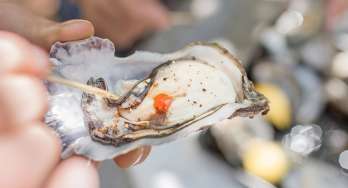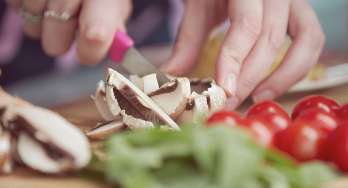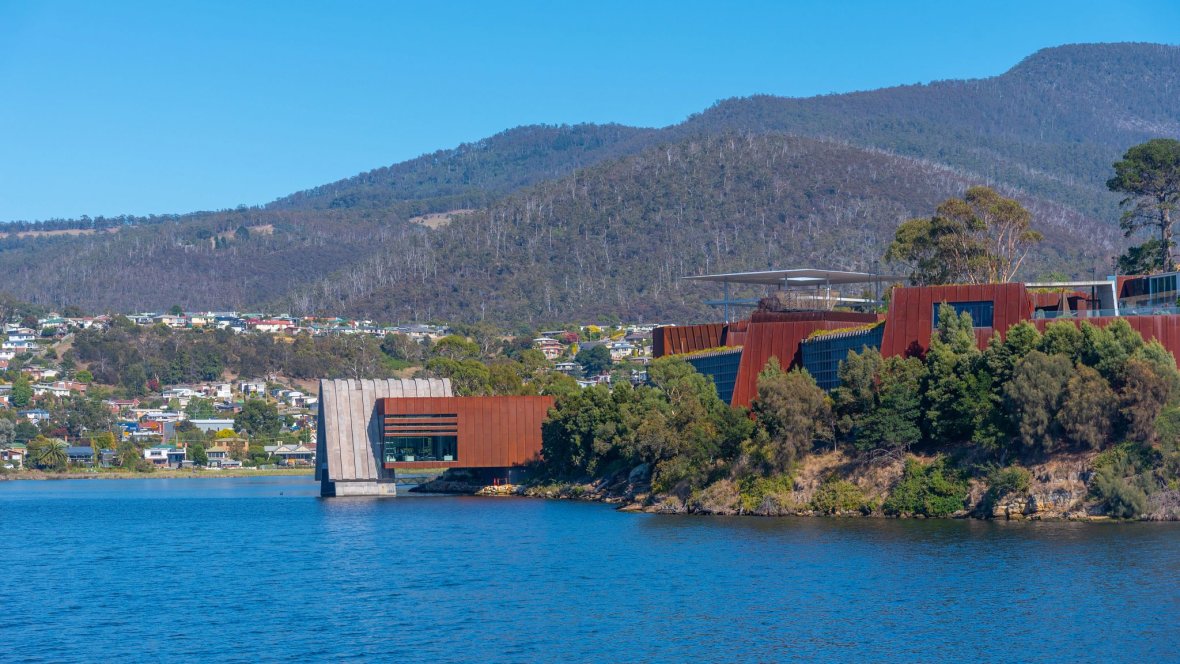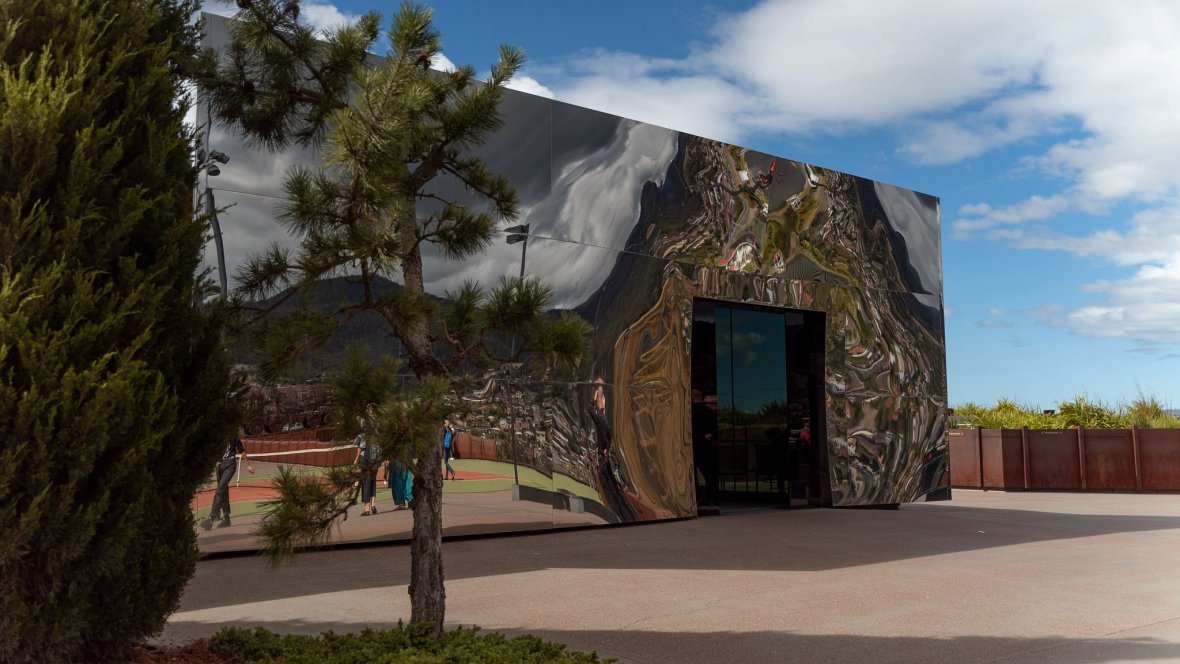


Join thousands of fellow campervan travellers
Sign up for our Britz newsletter to receive inspirational travel content and awesome deals, and we'll send you a copy of our Ultimate RV guide!
Thanks
Please confirm subscription in your email.
Is MONA Tasmania worth visiting?
In a word: absolutely. There’s something about stepping into MONA’s subterranean galleries that feels like stumbling into a secret society, only to discover everyone’s too busy having a great time to be secretive. Nestled on the banks of the River Derwent, the Museum of Old and New Art (MONA) is the largest privately funded museum in the Southern Hemisphere. And the art? Well, safe to say MONA’s collection is as eclectic as it is extensive.
Here you will find everything from the inaugural exhibition standout of Sidney Nolan’s “Snake,” to the “Cloaca Professional” (aka the “poo machine.”) that mimics the human digestive system, turning food into waste, and Egyptian mummies to immersive light installations. With MONA’s penchant for the provocative and its labyrinthine design, with winding corridors and hidden chambers, offers a completely unique touring experience and promises an unforgettable dive into the world of old and new art. From the playful to the jaw-dropping, topped off with a sprinkling of the bizarre— you’ll definitely have stories to share over dinner (and lucky for you there’s also a top-notch food and wine scene at Moorilla Estate right on site). And that is exactly why MONA has become one of the must-see Hobart tourist attractions (and well worth the visit!)
How long should you spend at MONA, Tasmania?
Think you’re just going to swing by for a quick hour of art-gazing? Good luck. This place pulls you in, winding deep into the bowels of the museum and begs you to get lost in its depths. Visitors can use an app to geo-locate themselves and explore nearby artworks, but even with a guide, at the bare minimum, budget three or four hours to dip your toes into the museum’s weirder corners—and trust us, you’ll find plenty.
If you’re an art aficionado (or easily distracted by shiny, obscure things), consider an entire day. That way, you can enjoy a leisurely lunch at The Source Restaurant, grab a drink at the atmospheric Void Bar, and maybe wrap up with a tasting flight at Moorilla. By then, you’ll definitely need time to process all the jaw-dropping installations you’ve encountered.

How to get to MONA
The museum’s location, just a short ferry ride from Hobart’s capital city, is easily accessible by boat and via car:
From Hobart (around 11 km, ~20 minutes)
-
MONA ferry Hobart: Fancy a scenic trip on River Derwent? Board at Brooke Street Pier, settle in for a 25-minute cruise on the MONA Roma ferry, (with an optional "Posh Pit" upgrade for those who like canapés, tiny food, and complimentary drinks with their views), and get whisked straight to MONA’s doorstep.
-
Self-drive: If you’ve got your camper and prefer to park closeby, take Brooker Highway for about 20 minutes and you’re there. Free parking onsite makes it even easier.
From Richmond (~30 km, 30–40 minutes)
-
Cruise via Midland Highway (A1), then Berriedale Road. Easy peasy.
From New Norfolk (~35 km, 35–45 minutes)
-
Follow Lyell Highway (A10), then hop onto the Brooker Highway (A1).
Best time to visit MONA
If you want to sidestep the crowds and have more “me time” with the artwork, swing by in autumn or spring on a weekday. If you’re the type who loves a buzzing festival, MONA’s got you covered there, too. Mona Foma (held in January) is a wild summer party of music and visual feasts, and Dark Mofo (held in June) brings provocative art, late-night revelry, and the (in)famous Nude Solstice Swim. Here are a few more tips:
Best Days & Times:
-
Weekdays: Less frantic than weekends—ideal if you prefer unhurried gallery-hopping.
-
Morning or Late Afternoon: Get in at 10am (when the doors open) to enjoy a quiet hour or two, or mosey in after 3pm for an end-of-day exploration.
Best Season to Visit:
-
Summer (Dec–Feb): Perfect for soaking up the summer sun, longer days, and Mona Foma festivities. Expect crowds, so book ahead.
-
Autumn (Mar–May): Gorgeous foliage, temperate weather, and fewer visitors—giving you space to fully appreciate the exhibits.
-
Winter (Jun–Aug): Chillier but oh-so-cool during Dark Mofo, complete with immersive performances and a carnival-like vibe.
-
Spring (Sep–Nov): Think mild temperatures, blooming gardens, and a gentler pace—just right for a reflective wander.
Weather for MONA
Tasmania is famous for its four-seasons-in-one-day unpredictability. In summer, temperatures hover between 20–25°C—lovely for outdoor art installations. Winter can dip down to about 5–12°C, so pack a coat for those crisp Tasmanian mornings. Autumn and spring can be pleasantly cool, with an average of around 40–50 rainy days a year in Hobart. The golden rule? Layer up. You’ll appreciate being able to peel off or pile on clothes as the day (and your mood) changes.

